How to perform a MIL-STD-461 CS114, Conducted susceptibility, bulk cable injection test[edit]
This application note explains how the MIL-STD-461 CS114, Conducted susceptibility, bulk cable injection test can be performed with RadiMation®
The exact requirements and test methods for the CS114 are specified in the MIL-STD-461.
Necessary equipment[edit]
The following devices are necessary to run this test:
- Signal generator
- Amplifier
- Coupler
- Forward power meter
- Current sensor
- Sensor power meter / Analyser
- 50 Ohm load
- 50 Ohm attenuator
- Current injection device
- Current injection calibration jig (Calibration fixture)
- Cable drivers with corrections
Configuration of the test sites[edit]
Calibration[edit]
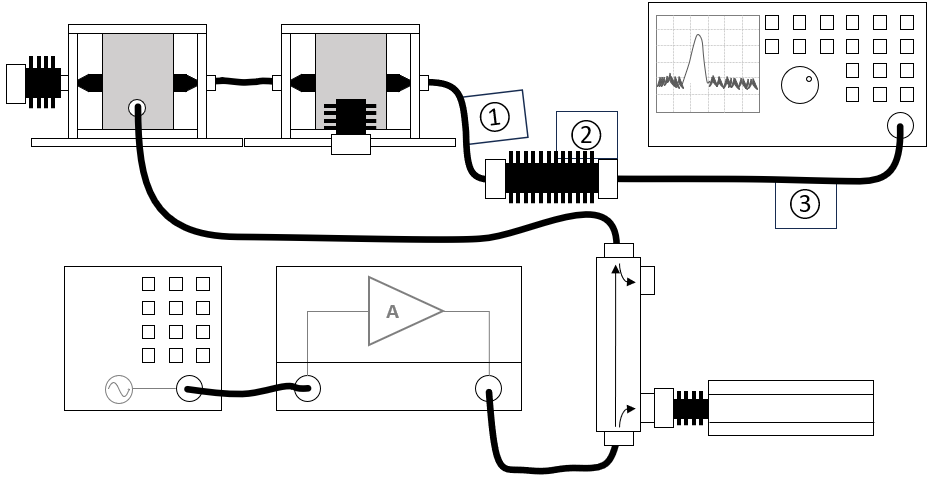
The configuration of the calibration test site should contain the following devices:
| # |
Device name |
Tab in testsite configuration window |
note
|
|
Signal Generator |
Devices 1 |
The signal generator to use
|
|
Amplifier |
Devices 1 |
The amplifier to use
|
|
Coupler |
Devices 1 |
The coupler to use
|
|
Forward power meter |
Devices 1 |
The forward power meter to use
|
|
Sensor powermeter |
Devices 2 |
The power meter or analyser to use for measuring the current
|
|
Current Sensor |
Devices 2 |
The current sensor to use with transfer factor attached to the driver
|
|
Injection device |
Devices 2 |
The injection clamp to use
|
|
Jig |
Devices 2 |
The jig to use
|
| Cables
|
| ① |
Cable current -> power meter |
Cables |
Cable (1) with a correction file specified for the cable loss
|
| ② |
Cable current -> power meter |
Cables |
Cable (2) with the specified loss of the used attenuator
|
| ③ |
Cable current -> power meter |
Cables |
Cable (3) with a correction file specified for the cable loss
|
Verification[edit]
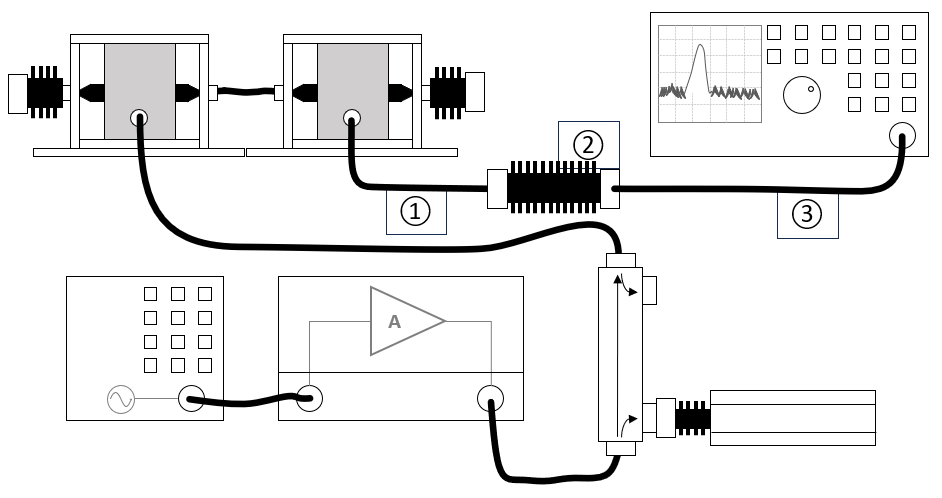
The configuration of the verification test site should contain the following devices:
| # |
Device name |
Tab in testsite configuration window |
note
|
|
Signal Generator |
Devices 1 |
The signal generator to use
|
|
Amplifier |
Devices 1 |
The amplifier to use
|
|
Coupler |
Devices 1 |
The coupler to use
|
|
Forward power meter |
Devices 1 |
The forward power meter to use
|
|
Sensor powermeter |
Devices 2 |
The power meter or analyser to use for measuring the current
|
|
Current Sensor |
Devices 2 |
The current sensor to use with transfer factor attached to the driver
|
|
Injection device |
Devices 2 |
The injection clamp to use
|
| Cables
|
| ① |
Cable current -> power meter |
Cables |
Cable (1) with a correction file specified for the cable loss
|
| ② |
Cable current -> power meter |
Cables |
Cable (2) with the specified loss of the used attenuator
|
| ③ |
Cable current -> power meter |
Cables |
Cable (3) with a correction file specified for the cable loss
|
EUT Testing[edit]
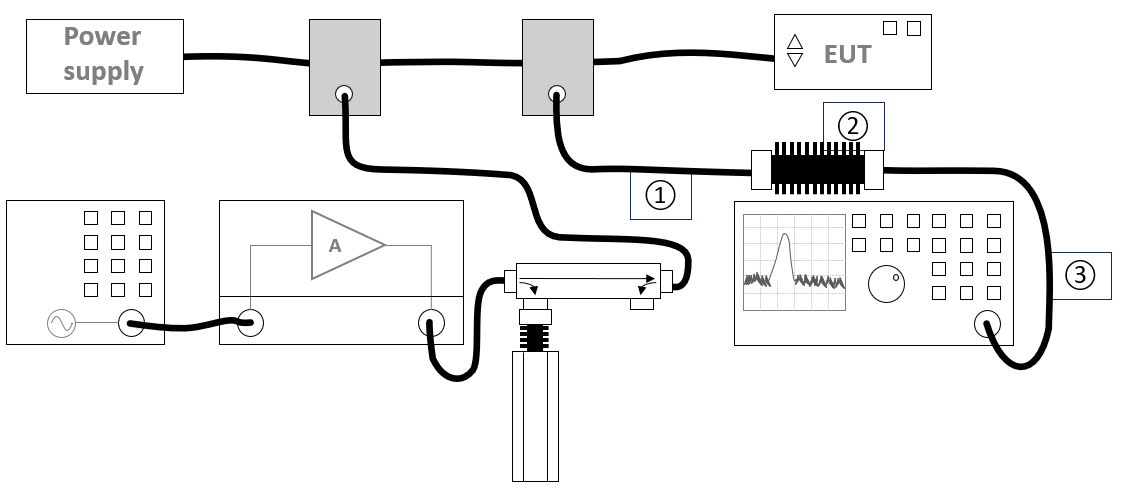
The configuration of the eut test site should contain the following devices:
| # |
Device name |
Tab in testsite configuration window |
note
|
|
Signal Generator |
Devices 1 |
The signal generator to use
|
|
Amplifier |
Devices 1 |
The amplifier to use
|
|
Coupler |
Devices 1 |
The coupler to use
|
|
Forward power meter |
Devices 1 |
The forward power meter to use
|
|
Sensor powermeter |
Devices 2 |
The power meter or analyser to use for measuring the current
|
|
Current Sensor |
Devices 2 |
The current sensor to use with transfer factor attached to the driver
|
|
Injection device |
Devices 2 |
The injection clamp to use
|
| Cables
|
| ① |
Cable current -> power meter |
Cables |
Cable (1) with a correction file specified for the cable loss
|
| ② |
Cable current -> power meter |
Cables |
Cable (2) with the specified loss of the used attenuator
|
| ③ |
Cable current -> power meter |
Cables |
Cable (3) with a correction file specified for the cable loss
|
Calibration procedure[edit]
Create a correction file for the test level[edit]
-
 File
File
-
 New
New
-
 Correction
Correction
First create a correction file in RadiMation® and specify the applicable test level (See 'TABLE IV CS114 limit curves.' and 'FIGURE CS114-1. CS114 calibration limits.').
In this example the limits for 'Aircraft (External or safety critical) / Curve 5 are configured.
Ensure that the correction file has a Frequency column and a Current column with the unit set to dBuA.
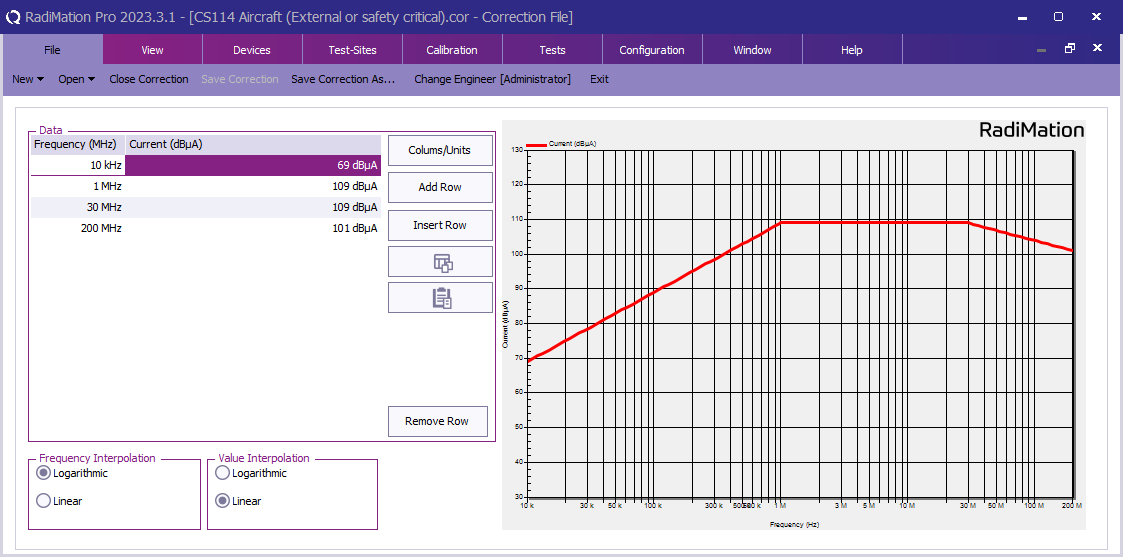
Create calibration test setup files[edit]
There are three frequency ranges that have to be calibrated with the following settings (see TABLE III).
| Band |
Frequency range |
Step size
|
| Band 1 |
10 kHz - 1 MHz |
5 %
|
| Band 2 |
1 MHz - 30 MHz |
1 %
|
| Band 2 |
30 MHz - 200 MHz |
0.5 %
|
These three bands can be configured and performed in three different calibrations. The calibration can be started from the menu by selecting:
-
 Calibration
Calibration
-
 System calibration
System calibration
-
 Conducted immunity
Conducted immunity
This example shows the settings for band 1.
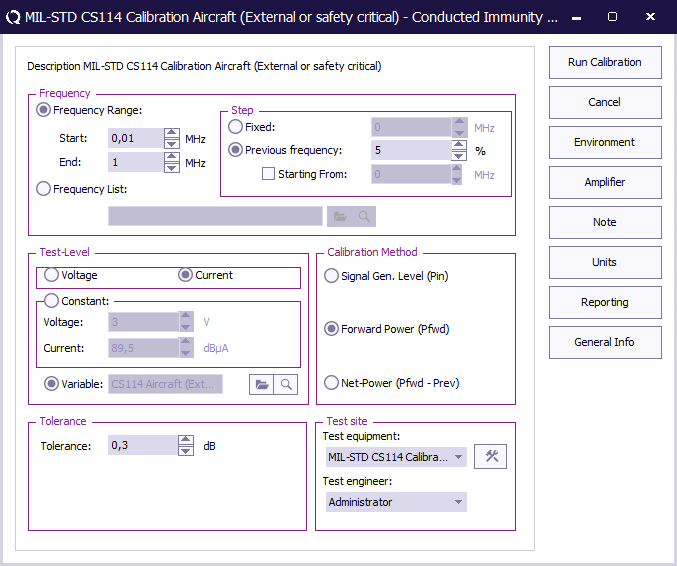
 Start Start
|
The start frequency of the test. For example 10 kHz.
|
 End End
|
The stop frequency of the test. For example 1 MHz.
|
 Step Step
|
The frequency step, in this case 5%.
|
 Test level Test level
|
The test level, in this case current.
|
 Variable Variable
|
The variable test level, select the correction file created earlier.
|
 Tolerance Tolerance
|
The regulation tolerance.
|
 Calibration method Calibration method
|
Forward power.
|
 Test equipment Test equipment
|
Calibration test equipment.
|
 Test engineer Test engineer
|
The engineer that performed the calibration.
|

|
Note:
|
If the current unit is shown as uA, it can be changed to dBuA by clicking Units, select Current and click Edit to change this.
|
Calibration result[edit]
When the calibration is performed, the engineer is asked, to save the results of that calibration to a calibration (.CAL) file. It is possible to give the .CAL file any clear and distinct name. All three bands have to calibrated, and at the end, there should be three different calibration files that are generated.
Verification[edit]
Create the Test Setup File (TSF)[edit]
CS114 requires to perform a verification of the setup with the probes in the calibration setup. With this verification it is important to verify that the forward power of the calibration is followed and that the generated current is within 3 dB tolerance of the current test limit.
The verification can be performed in RadiMation® by doing an actual conducted immunity test. This test can be started by selecting from the menu:
-
 Tests
Tests
-
 Conducted Immunity
Conducted Immunity
-
 Multiband
Multiband
Create a new multiband conducted immunity test and define three bands with the following settings:
| Band |
Frequency range |
Step size
|
| Band 1 |
10 kHz - 1 MHz |
10 %
|
| Band 2 |
1 MHz - 30 MHz |
2 %
|
| Band 2 |
30 MHz - 200 MHz |
1 %
|
Each band needs a test level defined with the test level Current substitution method and the appropriate calibration file attached.
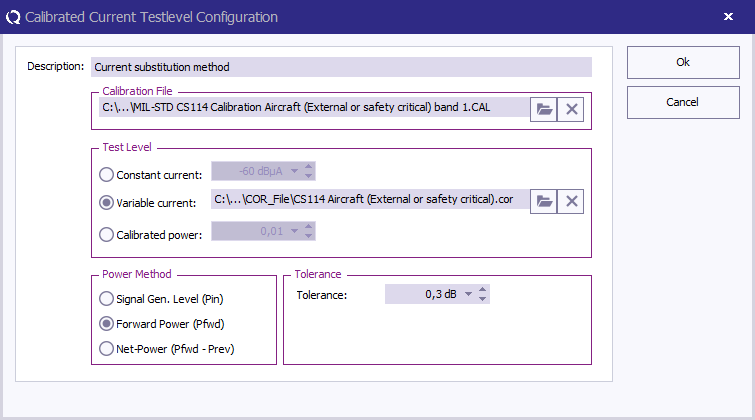
 Description Description
|
The description of the test level.
|
 Calibration file Calibration file
|
Select the calibration file to use.
|
 Test level Test level
|
Variable current, and specify the correction file for the applicable test level.
|
 Calibration method Calibration method
|
Select Forward Power.
|
 Tolerance Tolerance
|
Specify the tolerance to use.
|
Next to the test level add an input Current sensor, this will ensure that the current is measured during the test.

|
Note:
|
If the current unit is shown as uA, it can be changed to dBuA by clicking Units, select Current and click Edit to change this.
|
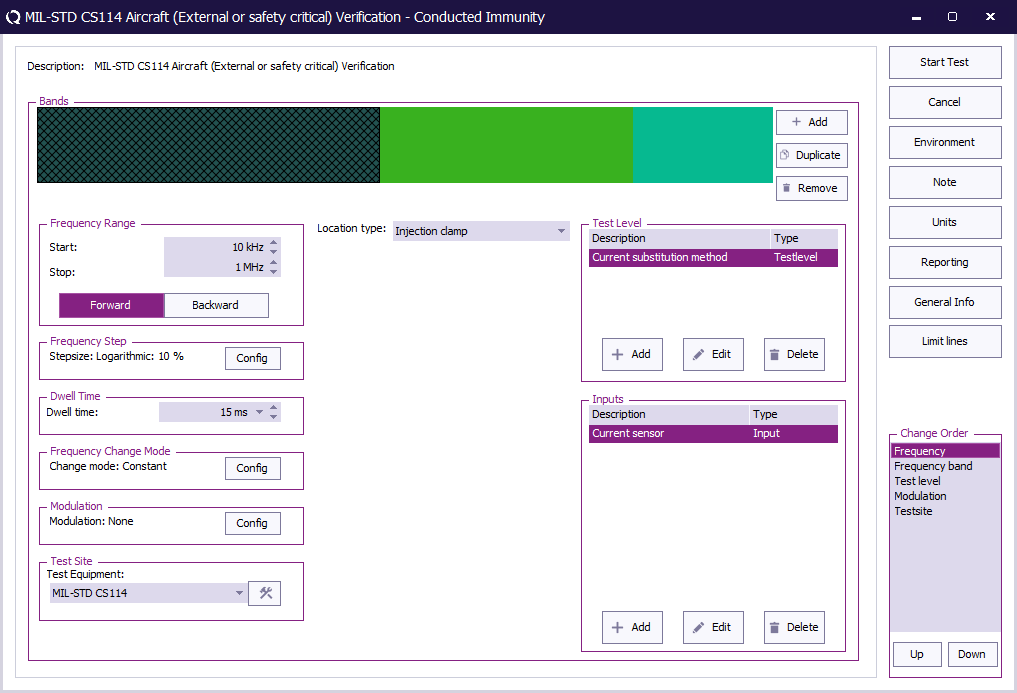
 Start Start
|
The start frequency of the test. For example 10 kHz.
|
 End End
|
The stop frequency of the test. For example 1 MHz.
|
 Frequency Step Frequency Step
|
The frequency step, see 5.12.3.4.c.3.
|
 Dwell Time Dwell Time
|
The dwell time specified see TABLE II.
|
 Frequency Change Mode Frequency Change Mode
|
Constant.
|
 Modulation Modulation
|
Modulation is optional during the verification.
|
 Test equipment Test equipment
|
The equipment needed for the verification.
|
 Location Type Location Type
|
Injection clamp.
|
 Test Level Test Level
|
Specify the current substitution method.
|
 Inputs Inputs
|
Add the current sensor as an input.
|
Run the verification test[edit]
When all settings are configured press Start Test to run the verification test.
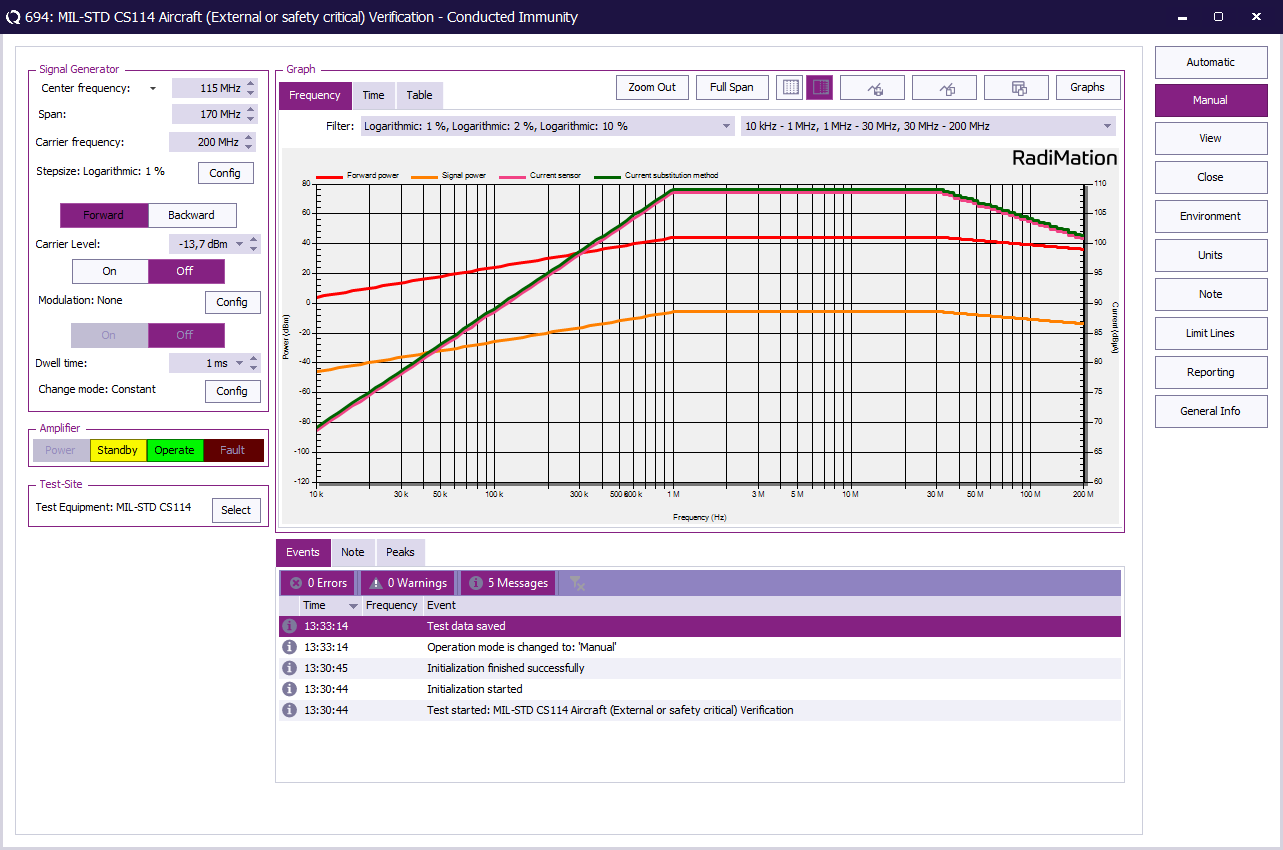
Verification result[edit]
With the result of the verification it should be possible to determine if the measured current is within the 3 dB tolerance of the current test limit as specified in clause 5.12.3.4.c of the MIL-STD-461.
EUT Testing[edit]
Create the Test Setup File (TSF)[edit]
To perform the actual test on the EUT, create a conducted immunity multiband test with 3 bands.
The conducted immunity multiband test, can be started by selecting from the menu:
-
 Tests
Tests
-
 Conducted Immunity
Conducted Immunity
-
 Multiband
Multiband
The following bands should be configured.
| Band |
Frequency range |
Step size
|
| Band 1 |
10 kHz - 1 MHz |
5 %
|
| Band 2 |
1 MHz - 30 MHz |
1 %
|
| Band 2 |
30 MHz - 200 MHz |
0.5 %
|

|
Note:
|
If the current unit is shown as uA, it can be changed to dBuA by clicking Units, select Current and click Edit to change this.
|
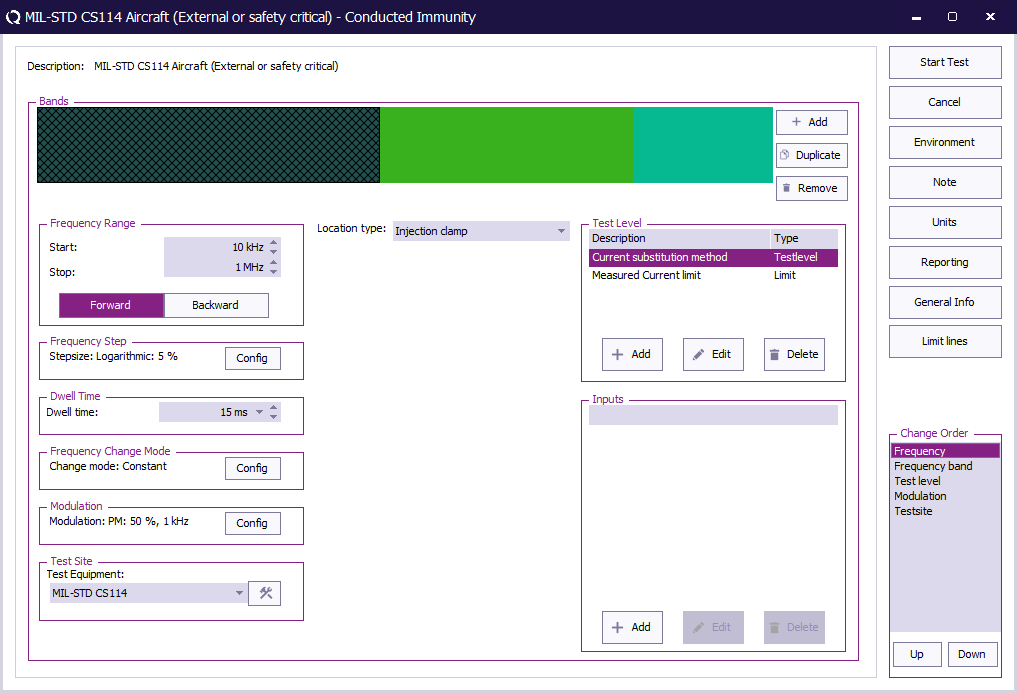
 Start Start
|
The start frequency of the test. For example 10 kHz.
|
 End End
|
The stop frequency of the test. For example 1 MHz.
|
 Frequency Step Frequency Step
|
The frequency step, see Table III.
|
 Dwell Time Dwell Time
|
The dwell time.
|
 Frequency Change Mode Frequency Change Mode
|
Constant.
|
 Modulation Modulation
|
Configure Pulse Modulation with 1 kHz and 50% duty cycle.
|
 Test equipment Test equipment
|
The equipment needed for the conducted immunity test.
|
 Location Type Location Type
|
Injection clamp.
|
 Test Level Test Level
|
Specify the current substitution method. Also add a "Measured Current Limit"
|
 Inputs Inputs
|
No inputs are needed.
|
To configure the pulse modulation settings click Config next to the modulation settings, click the PM tab, and enter the pulse modulation settings as defined in 5.12.3.4.d.1.
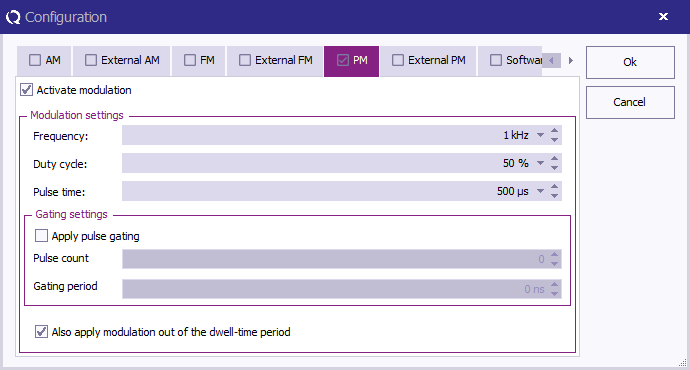
 Activate modulation Activate modulation
|
Check this checkbox to enable the pulse modulation.
|
 Frequency Frequency
|
The PM frequency 1 kHz.
|
 Duty Cycle Duty Cycle
|
A duty cycle of 50%.
|
At TestLevel click Add to add a new Test level and select TestLevel - Current substitution method

 Description Description
|
The description of the test level.
|
 Calibration file Calibration file
|
Select the calibration file to use for this band.
|
 Test level Test level
|
Variable current, and specify the correction file for the applicable test level.
|
 Calibration method Calibration method
|
Select Forward Power.
|
 Tolerance Tolerance
|
Specify the tolerance to use.
|
Next to the test level add a limit, At TestLevel click Add to add a new Limit and select Limit - Measured Current Limit
With this limit the level will not be regulated higher than the measured current in the cable even if the forward power is not reached yet.
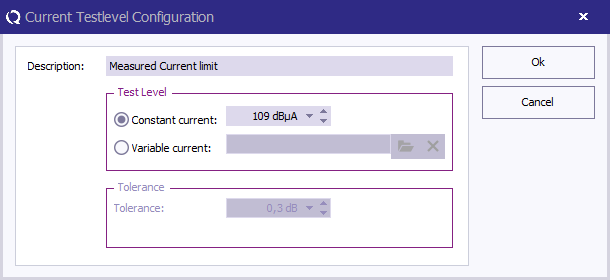
 Description Description
|
The description of the limit
|
 Constant current Constant current
|
The current to limit on.
|
When all bands are configured press Start Test to run the EUT test.
EUT Test Result[edit]
Once the test is finished, the results of this test are stored in the EUT file and available as one of the performed Tests in the EUT file. Selecting the corresponding test result and pressing on Info will show the test results again.
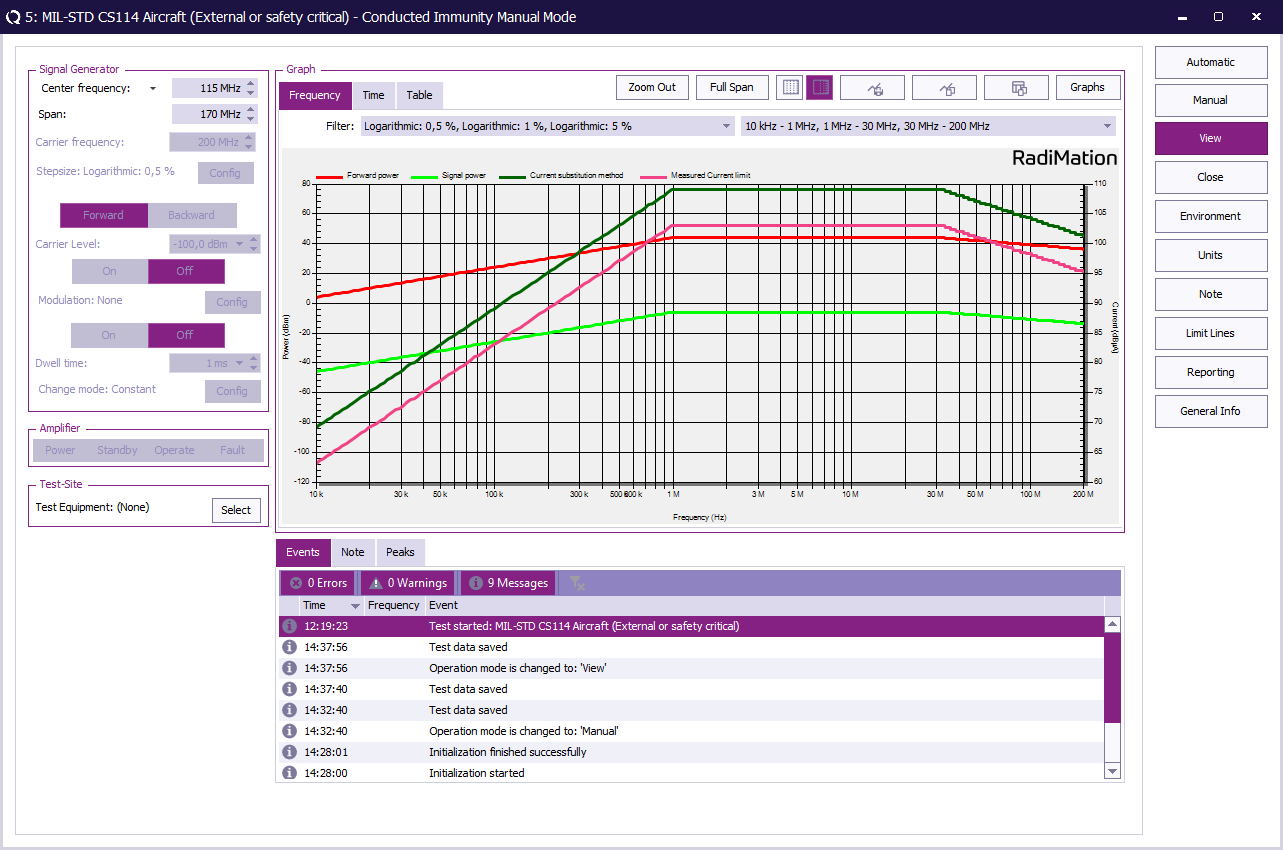
Conclusion[edit]
The RadiMation® Conducted Immunity multiband test can be used to perform the CS114 verification and the EUT test with a calibration file and the current sensor used as a limit in the EUT test.
 File
File
 New
New
 Correction
Correction  Calibration
Calibration
 System calibration
System calibration
 Conducted immunity
Conducted immunity  Tests
Tests
 Conducted Immunity
Conducted Immunity
 Multiband
Multiband  Tests
Tests
 Conducted Immunity
Conducted Immunity
 Multiband
Multiband 










